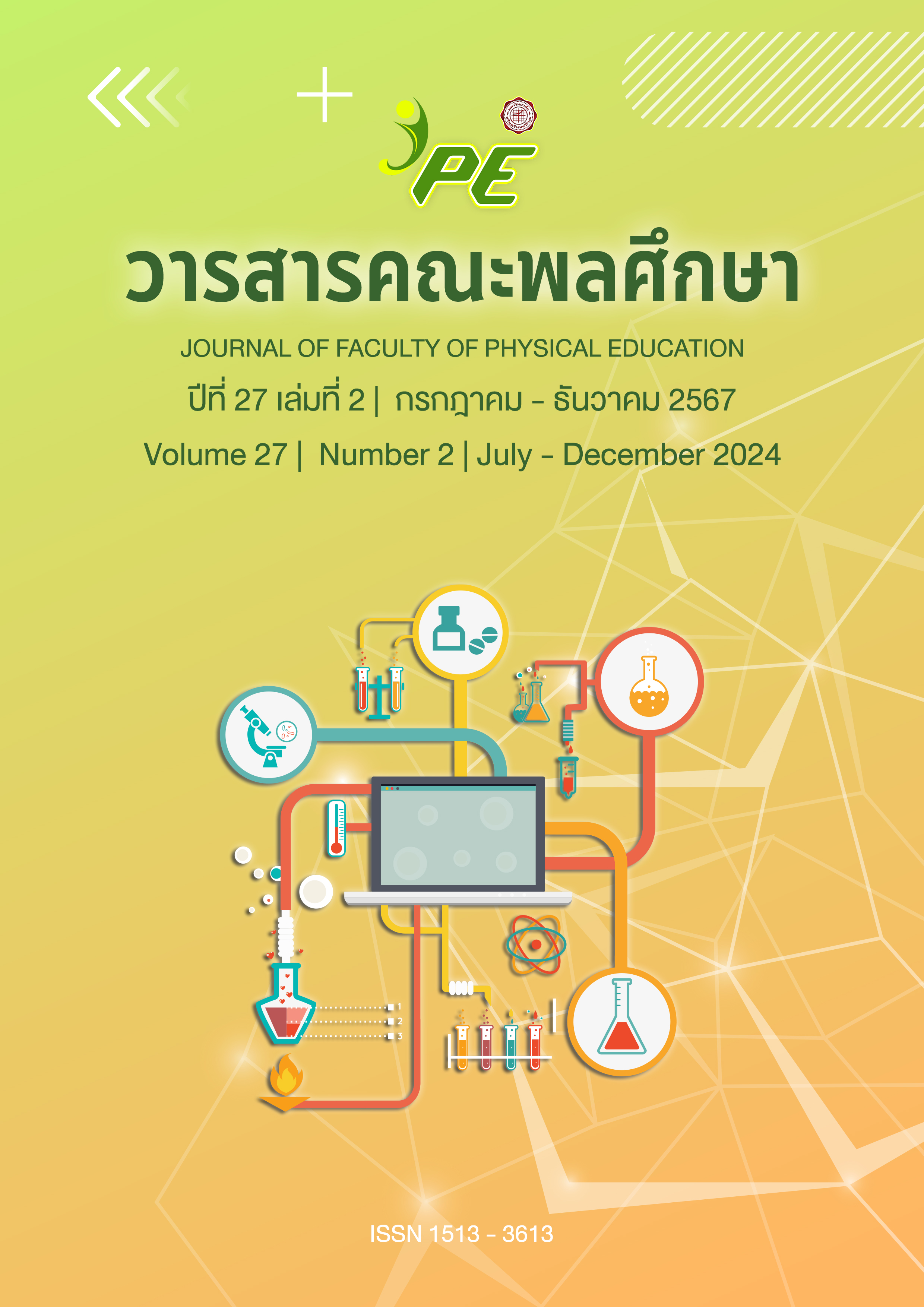การประเมินความเสี่ยงสุขภาพของพนักงานกายวิภาคศาสตร์จากการรับ สัมผัสสารฟอร์มัลดีไฮด์โดยใช้เครื่องมืออ่านค่าโดยตรง
Main Article Content
บทคัดย่อ
สารฟอร์มัลดีไฮด์เป็นสารเคมีอันตรายที่ใช้กันอย่างแพร่หลายในปัจจุบัน สามารถก่อให้เกิดอันตรายต่อมนุษย์และจัดเป็นสารก่อมะเร็ง งานวิจัยนี้มีวัตถุประสงค์เพื่อประเมินความเสี่ยงสุขภาพจากการรับสัมผัสสารฟอร์มัลดีไฮด์ของผู้พนักงานกายวิภาคศาสตร์ที่ปฏิบัติงานภายในห้องปฏิบัติการกายวิภาคศาสตร์ทั้ง 4 กระบวนการ ด้วยแบบสัมภาษณ์ เครื่องมือวัดความเข้มข้นของสารฟอร์มัลดีไฮด์แบบอ่านค่าโดยตรง และเครื่องตรวจวัดคุณภาพอากาศภายในอาคาร ผลการศึกษาพบว่า ความเข้มข้นของสารฟอร์มัลดีไฮด์ในสิ่งแวดล้อมการทำงานไม่เป็นไปตามเกณฑ์มาตรฐานตามประกาศกรมสวัสดิการและคุ้มครองแรงงาน จำนวน 2 กระบวนการ การประเมินความเสี่ยงสุขภาพพบว่าพนักงาน มีความเสี่ยงของการก่อเกิดมะเร็ง (CR) จากการได้รับสัมผัสสารฟอร์มัลดีไฮด์อยู่ในระดับที่ยอมรับไม่ได้ จำนวน 4 กระบวนการ และมีความเสี่ยงของการไม่ก่อมะเร็ง (HQ) จำนวน 3 กระบวนการ ซึ่งมีเพียงกระบวนการฉีดน้ำยารักษาสภาพร่างอาจารย์ใหญ่และการดองร่าง กระบวนการเดียวเท่านั้นที่อยู่ในระดับที่ยอมรับได้ จากการศึกษานี้พบว่าพนักงานกายวิภาคศาสตร์มีโอกาสที่จะผลกระทบทางสุขภาพจากการทำงานที่ได้รับสัมผัสสารฟอร์มัลดีไฮด์ในทุกกระบวนการทำงาน จึงเสนอให้พิจารณาปรับปรุงสภาพแวดล้อมในการทำงาน เช่น ระบบระบายอากาศที่เหมาะสม เพื่อควบคุมปริมาณความเข้มข้นสารเคมีในสภาพแวดล้อมการทำงานและลดการรับสัมผัสของพนักงานต่อไป
Article Details

This work is licensed under a Creative Commons Attribution-NonCommercial-NoDerivatives 4.0 International License.
บทความและข้อคิดเห็นใดๆ ในวารสาร เป็นทัศนะของผู้เขียน คณะพลศึกษาไม่จำเป็นต้องเห็นชอบด้วยเสมอไปผู้ใดประสงค์จะนำข้อความไปตีพิมพ์หรือเผยแพร่ต้องได้รับอนุญาตจากผู้เขียนโดยตรง
References
Khoshakhlagh, A. H., Mohammadzadeh, M., Manafi, S. S., Yousefian, F., & Gruszecka-Kosowska, A.
(2023b). Inhalational exposure to formaldehyde, carcinogenic, and non-carcinogenic risk assessment: A
systematic review. Environmental Pollution, 121854.
Kim, K.-H., Jahan, S. A., & Lee, J.-T. (2011). Exposure to formaldehyde and its potential human health
hazards. Journal of Environmental Science and Health, Part C, 29(4), 277-299.
Klein, L. W., Miller, D. L., Balter, S., Laskey, W., Haines, D., Norbash, A., Mauro, M. A., & Goldstein, J. A.
(2009). Occupational health hazards in the interventional laboratory: time for a safer environment.
Radiology, 250(2), 538-544.
Lakchayapakorn, K., & Watchalayarn, P. (2010). Formaldehyde exposure of medical students and
instructors and clinical symptoms during gross anatomy laboratory in Thammasat University. J Med
Assoc Thai, 93(Suppl 7), S92-98.
Le, A. D. T., Zhang, J. S., & Liu, Z. (2021). Impact of humidity on formaldehyde and moisture buffering
capacity of porous building material. Journal of Building Engineering, 36, 102114.
Liang, W., Lv, M., & Yang, X. (2016). The combined effects of temperature and humidity on initialemittable
formaldehyde concentration of a medium-density fiberboard. Building and Environment, 98, 80-88.
Ministry of Labour (2011). Occupational Safety, Health and Environment Act B.E. 2011. Retrieved 2023
Dec 12 from https://www.tosh.or.th/images/file/2016/osh-act.b.e.2554.pdf
Montgomery, J. F., Storey, S., & Bartlett, K. (2015). Comparison of the indoor air quality in an office
operating with natural or mechanical ventilation using short-term intensive pollutant monitoring. Indoor
and Built Environment, 24(6), 777-787.
National Institutes of Health. (2009). Natural Ventilation for Infection Control in Health-Care Settings.
Retrieved 2023 Dec 11 from https://www.ncbi.nlm.nih.gov/books/NBK143277/
Norkaew, S., Thammabut, P., Chaiyadej, R., Changkaew, K., Yamasamit, N., & Ketsakorn, A. (2021).
Indoor air quality and its associations with skin related syndrome among medical students during gross
anatomy dissection. Journal of Science & Technology MSU, 40(2).
Occupational Safety and Health Administration. Identifying Hazard Control Options the Hierarchy of
Controls. Retrieved 23 Feb 2024, from
https://www.osha.gov/sites/default/files/Hierarchy_of_Controls_02.01.23_form_508_2.pdf
OSHA. (2011). Formaldehyde. us. department of labor. Retrieved 2022 Jun 12 from
https://www.osha.gov/laws-regs/regulations/standardnumber/1910/1910.1048
Pei, J., Qu, M., Sun, L., Wang, X., & Yin, Y. (2022). The relationship between indoor air quality (IAQ) and
perceived air quality (PAQ)–a review and case analysis of Chinese residential environment. Energy and
Built Environment.
Pokorski, M. (2017). Pulmonary care and clinical medicine. Springer.
Qu, M., Lu, J., & He, R. (2017). Formaldehyde from environment. Formaldehyde and cognition, 1, 1-19.
Risner, C. H., & Martin, P. (1994). Quantitation of formaldehyde, acetaldehyde, and acetone in sidestream
cigarette smoke by high-performance liquid chromatography. Journal of chromatographic science, 32(3),
-82.
Suan Prung hospital. (2021). Occupational health, safety, and working environment manual. Committee on
Occupational Health, Safety and Working Environment Suan Prung Hospital. Retrieved 2023 Dec 10
from https://www.suanprung.go.th/suanprung2021/pdf/guide_green.pdf
Tanaka, K., Nishiyama, K., Yaginuma, H., Sasaki, A., Maeda, T., Kaneko, S., Onami, T., & Tanaka, M.
(2003). Formaldehyde exposure levels and exposure control measures during an anatomy dissecting
course. Kaibogaku zasshi. Journal of anatomy, 78(2), 43-51.
The National Institute for Occupational Safety and Health. (2019). Formaldehyde. Retrieved 2024 May 12
from https://www.cdc.gov/niosh/npg/npgd0293.html
Tiruneh, C. (2021). Acute adverse effects of formaldehyde treated cadaver on new innovative medical
students and anatomy staff members in the dissection Hall at Wollo University, Northeast Ethiopia.
Advances in medical education and practice, 41-47.
U.S. Environmental Protection Agency. (1991). Integrated Risk Information System (IRIS): Formaldehyde;
CASRN 50-00-0 https://cfpub.epa.gov/ncea/iris/iris_documents/documents/subst/0419_
summary.pdf#nameddest=woe
U.S. Environmental Protection Agency. (2009). Risk assessment guidance for superfund volume I: human
health evaluation manual (Part F, supplemental guidance for inhalation risk assessment)
https://www.epa.gov/sites/default/files/2015-09/documents/partf_200901_final.pdf
World Health Organization (2010). WHO guidelines for indoor air quality: selected pollutants. World Health
Organization. Regional Office for Europe.

